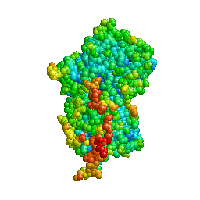Z-alpha1-antitrypsin polymers and small airways disease: a new paradigm in alfa-1 anti-trypsin deficiency-related COPD development?

Published: June 8, 2021
Abstract Views: 3414
PDF: 1152
Publisher's note
All claims expressed in this article are solely those of the authors and do not necessarily represent those of their affiliated organizations, or those of the publisher, the editors and the reviewers. Any product that may be evaluated in this article or claim that may be made by its manufacturer is not guaranteed or endorsed by the publisher.
All claims expressed in this article are solely those of the authors and do not necessarily represent those of their affiliated organizations, or those of the publisher, the editors and the reviewers. Any product that may be evaluated in this article or claim that may be made by its manufacturer is not guaranteed or endorsed by the publisher.
Similar Articles
- Pierfranco Terrosu, Aspirin use for primary prevention in elderly patients , Monaldi Archives for Chest Disease: Vol. 84 No. 1-2 (2015): Cardiac series
- I.A. Brownlee, A. Aseeri, C. Ward, J.P. Pearson, From gastric aspiration to airway inflammation , Monaldi Archives for Chest Disease: Vol. 73 No. 2 (2010): Pulmonary series
- I. Blanco, H. Canto, J. Flóres, C. Camblor, V. Cárcaba, F.J. de Serres, S. Janciauskiene, E.F. Bustillo, Long-term augmentation therapy with Alpha-1 Antitrypsin in an MZ-AAT severe persistent asthma , Monaldi Archives for Chest Disease: Vol. 69 No. 4 (2008): Pulmonary series
- Dhruv Talwar, Sourabh Pahuja, Deepak Prajapat, Kanishka Kumar, Anupam Prakash, Deepak Talwar, Small airway involvement in severe asthma: how common is it and what are its implications? , Monaldi Archives for Chest Disease: Early Access
- Sergio C. Conte, Giulia Spagnol, Marco Confalonieri, Beatrice Brizi, Deep sedation versus minimal sedation during endobronchial ultrasound transbronchial needle aspiration , Monaldi Archives for Chest Disease: Vol. 88 No. 3 (2018)
- Charalampos Mermigkis, Sophia E. Schiza, Panagiotis Panagou, Multum non multa: airway distensibility by forced oscillations , Monaldi Archives for Chest Disease: Vol. 81 No. 1-2 (2015): Pulmonary series
- G.L. Casoni, C. Gurioli, P.N. Chhajed, M. Chilosi, M. Zompatori, D. Olivieri, V. Poletti, The value of transbronchial lung biopsy using jumbo forceps via rigid bronchoscope in diffuse lung disease , Monaldi Archives for Chest Disease: Vol. 69 No. 2 (2008): Pulmonary series
- F.J. de Serres, M. Luisetti, I. Ferrarotti, I. Blanco, E. Fernández-Bustillo, Alpha-1 antitrypsin deficiency in Italy: regional differences of the PIS and PIZ deficiency alleles , Monaldi Archives for Chest Disease: Vol. 63 No. 3 (2005): Pulmonary series
- F.J. de Serres, I. Blanco, E. Fernández-Bustillo, PI S and PI Z Alpha-1 antitrypsin deficiency worldwide. A review of existing genetic epidemiological data , Monaldi Archives for Chest Disease: Vol. 67 No. 4 (2007): Pulmonary series
- F.J. de Serres, I. Blanco, E. Fernández-Bustillo, Estimates of PI*S and PI*Z Alpha-1 antitrypsin deficiency alleles prevalence in the Caribbean and North, Central and South America , Monaldi Archives for Chest Disease: Vol. 71 No. 3 (2009): Pulmonary series
You may also start an advanced similarity search for this article.

 https://doi.org/10.4081/monaldi.2021.1883
https://doi.org/10.4081/monaldi.2021.1883





